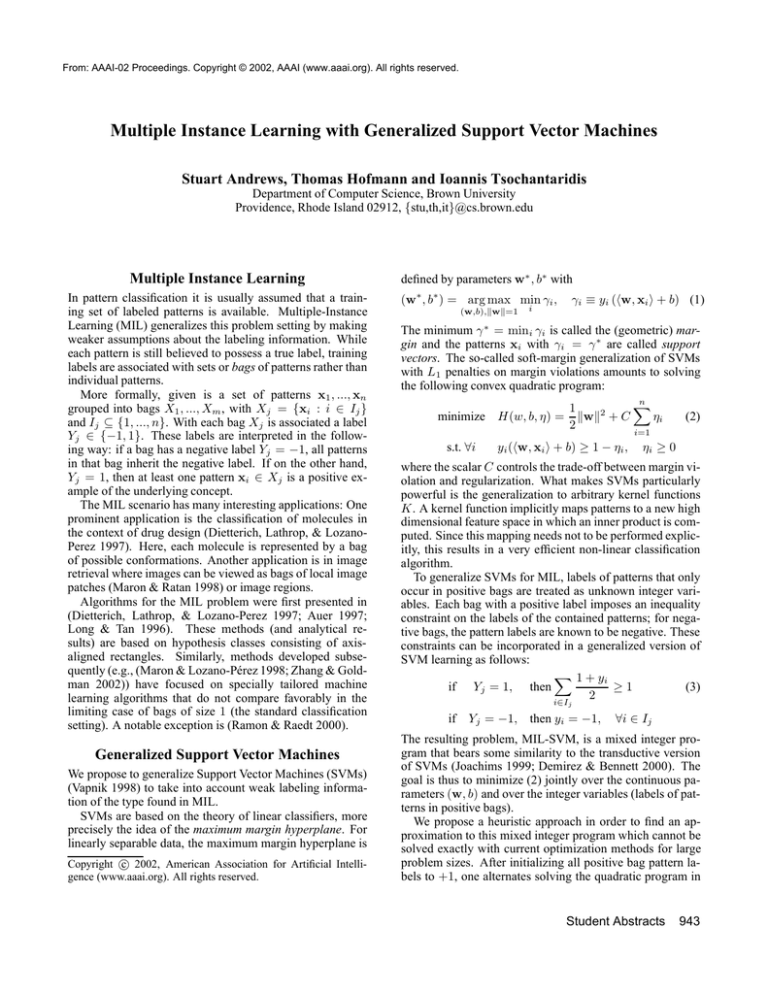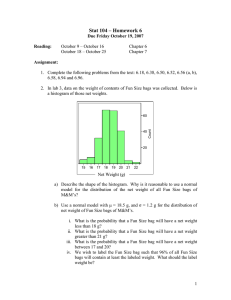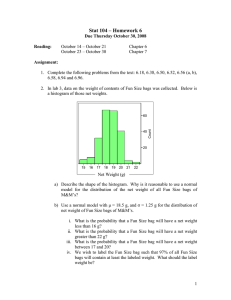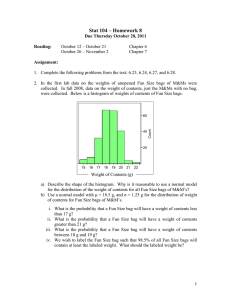
From: AAAI-02 Proceedings. Copyright © 2002, AAAI (www.aaai.org). All rights reserved.
Multiple Instance Learning with Generalized Support Vector Machines
Stuart Andrews, Thomas Hofmann and Ioannis Tsochantaridis
Department of Computer Science, Brown University
Providence, Rhode Island 02912, {stu,th,it}@cs.brown.edu
Multiple Instance Learning
In pattern classification it is usually assumed that a training set of labeled patterns is available. Multiple-Instance
Learning (MIL) generalizes this problem setting by making
weaker assumptions about the labeling information. While
each pattern is still believed to possess a true label, training
labels are associated with sets or bags of patterns rather than
individual patterns.
More formally, given is a set of patterns x1 , ..., xn
grouped into bags X1 , ..., Xm , with Xj = {xi : i ∈ Ij }
and Ij ⊆ {1, ..., n}. With each bag Xj is associated a label
Yj ∈ {−1, 1}. These labels are interpreted in the following way: if a bag has a negative label Yj = −1, all patterns
in that bag inherit the negative label. If on the other hand,
Yj = 1, then at least one pattern xi ∈ Xj is a positive example of the underlying concept.
The MIL scenario has many interesting applications: One
prominent application is the classification of molecules in
the context of drug design (Dietterich, Lathrop, & LozanoPerez 1997). Here, each molecule is represented by a bag
of possible conformations. Another application is in image
retrieval where images can be viewed as bags of local image
patches (Maron & Ratan 1998) or image regions.
Algorithms for the MIL problem were first presented in
(Dietterich, Lathrop, & Lozano-Perez 1997; Auer 1997;
Long & Tan 1996). These methods (and analytical results) are based on hypothesis classes consisting of axisaligned rectangles. Similarly, methods developed subsequently (e.g., (Maron & Lozano-Pérez 1998; Zhang & Goldman 2002)) have focused on specially tailored machine
learning algorithms that do not compare favorably in the
limiting case of bags of size 1 (the standard classification
setting). A notable exception is (Ramon & Raedt 2000).
Generalized Support Vector Machines
We propose to generalize Support Vector Machines (SVMs)
(Vapnik 1998) to take into account weak labeling information of the type found in MIL.
SVMs are based on the theory of linear classifiers, more
precisely the idea of the maximum margin hyperplane. For
linearly separable data, the maximum margin hyperplane is
c 2002, American Association for Artificial IntelliCopyright gence (www.aaai.org). All rights reserved.
defined by parameters w∗ , b∗ with
(w∗ , b∗ ) = arg max min γi ,
(w,b),kwk=1
i
γi ≡ yi (hw, xi i + b) (1)
The minimum γ ∗ = mini γi is called the (geometric) margin and the patterns xi with γi = γ ∗ are called support
vectors. The so-called soft-margin generalization of SVMs
with L1 penalties on margin violations amounts to solving
the following convex quadratic program:
n
minimize H(w, b, η) =
s.t. ∀i
X
1
kwk2 + C
ηi
2
i=1
yi (hw, xi i + b) ≥ 1 − ηi ,
(2)
ηi ≥ 0
where the scalar C controls the trade-off between margin violation and regularization. What makes SVMs particularly
powerful is the generalization to arbitrary kernel functions
K. A kernel function implicitly maps patterns to a new high
dimensional feature space in which an inner product is computed. Since this mapping needs not to be performed explicitly, this results in a very efficient non-linear classification
algorithm.
To generalize SVMs for MIL, labels of patterns that only
occur in positive bags are treated as unknown integer variables. Each bag with a positive label imposes an inequality
constraint on the labels of the contained patterns; for negative bags, the pattern labels are known to be negative. These
constraints can be incorporated in a generalized version of
SVM learning as follows:
X 1 + yi
≥1
(3)
if Yj = 1, then
2
i∈Ij
if
Yj = −1, then yi = −1,
∀i ∈ Ij
The resulting problem, MIL-SVM, is a mixed integer program that bears some similarity to the transductive version
of SVMs (Joachims 1999; Demirez & Bennett 2000). The
goal is thus to minimize (2) jointly over the continuous parameters (w, b) and over the integer variables (labels of patterns in positive bags).
We propose a heuristic approach in order to find an approximation to this mixed integer program which cannot be
solved exactly with current optimization methods for large
problem sizes. After initializing all positive bag pattern labels to +1, one alternates solving the quadratic program in
Student Abstracts
943
Figure 1: SVM (black), SVM with true labels (yellow), intermediate MIL-SVM (blue), MIL-SVM final (green) and correct
(magenta) solutions on two synthetic data sets. Red and blue circles depict one positive bag and one negative bag on the
left-hand images. On the right, blue circles indicate examples from positive bags that have been re-labeled yi = −1.
(2) using the given labels, with a re-labeling step where the
labels of patterns in positive bags are updated. Alternating
these two steps defines a convergent procedure which will
lead to a local optimum. Our current implementation swaps
the label of a positive bag pattern that leads to the largest
decrease in the objective (2) while not violating constraints
in (3).
Results
We have experimentally verified the proposed generalization
of SVMs on synthetic data, by comparing it with a naive
baseline application of SVMs (labeling all patterns with the
label of the bag they belong to) and with an optimal application of SVMs (labeling all patterns with the true concept
label). A proof of concept on synthetic data is shown in
Fig. 1 which shows that the MIL generalization of SVMs
is able to identify superior discriminant functions, which is
also reflected in a significantly reduced error rate.
A second preliminary series of experiments has been performed on a data set of 1000 images from the Corel image
data base, preprocessed with the Blobworld system (Carson
et al. 1999). In this representation, an image consists of
a set of segments (or blobs), each characterized by color,
texture and shape descriptors. Although standard SVMs already perform quite well, we have been able to achieve relative improvements in average precision in the range of 10%
(e.g., from 25.3% to 30.3% for the “tiger” and from 43.2%
to 46.0% for the “elephant” category). We are currently investigating ways to find better optimization heuristics and
are conducting benchmark experiments on a larger scale.
Acknowledgments
Thanks to Chad Carson and the Blobworld team for making the
Blobworld Matlab code publically available.
References
Auer, P. 1997. On learning from multi-instance examples: Empirical evaluation of a theoretical approach. In Proc. 14th International Conference on Machine Learning, 21–29. Morgan
Kaufmann.
944
Student Abstracts
Carson, C.; Thomas, M.; Belongie, S.; Hellerstein, J. M.; and
Malik, J. 1999. Blobworld: A system for region-based image indexing and retrieval. In Third International Conference on Visual
Information Systems. Springer.
Demirez, A., and Bennett, K. 2000. Optimization approaches
to semisupervised learning. In Ferris, M.; Mangasarian, O.; and
Pang, J., eds., Applications and Algorithms of Complementarity.
Kluwer Academic Publishers, Boston.
Dietterich, T. G.; Lathrop, R. H.; and Lozano-Perez, T. 1997.
Solving the multiple instance problem with axis-parallel rectangles. Artificial Intelligence 89(1-2):31–71.
Joachims, T. 1999. Transductive inference for text classification
using support vector machines. In Proc. 16th International Conf.
on Machine Learning, 200–209. Morgan Kaufmann, San Francisco, CA.
Long, P., and Tan, L. 1996. PAC learning axis aligned rectangles with respect to product distributions from multiple-instance
examples. In Proceedings of the Conference on Computational
Learning Theory, 228–234.
Maron, O., and Lozano-Pérez, T. 1998. A framework for
multiple-instance learning. In Jordan, M. I.; Kearns, M. J.; and
Solla, S. A., eds., Advances in Neural Information Processing
Systems, volume 10. The MIT Press.
Maron, O., and Ratan, A. L. 1998. Multiple-instance learning for
natural scene classification. In Proc. 15th International Conf. on
Machine Learning, 341–349. Morgan Kaufmann, San Francisco,
CA.
Ramon, J., and Raedt, L. D. 2000. Multi instance neural networks. In Proceedings of IMCL-2000 Workshop on AttributeValue and Relational Learning.
Vapnik, V. 1998. Statistical Learning Theory. Wiley.
Zhang, Q., and Goldman, S. A. 2002. EM-DD: An improved
multiple-instance learning technique. In Advances in Neural Information Processing Systems.





